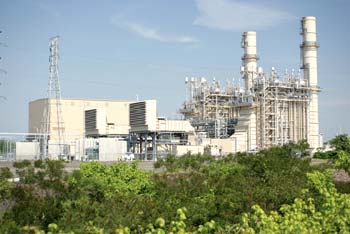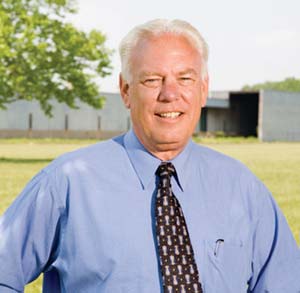

COVER STORY
From Site Selection magazine, July 2005
U.S. Steel Real Estate Gives Pennsylvania
Industrial Port Complex a New Lease on Life
| S |
tephen Bilan, a relative newcomer to industrial corporate real estate, is taking a different tack in his mission to utilize property assets at U.S. Steel's Keystone Industrial Port Complex (KIPC, formerly known as USS Fairless Works) in Bucks County, Pa. Bilan, an IAMC member, is regional manager at USS Real Estate's Fairless Hills location; he
 |
| The Keystone Industrial Port Complex in Bucks County, Pa., includes a deepwater port and dual rail service. |
Rather than turn the property into a residential or resort development, as has been the case with other U.S. Steel property assets, Bilan and his team are working to lure heavy industry to the site. Once there, companies would join a U.S. Steel Galvanized Finishing Line operation and several other tenants, including Dominion Energy, Exelon and Kinder Morgan Bulk Terminals, which operates the port at the site.
Several years ago, U.S. Steel shuttered its sheet metal and tin operations at the site, which had occupied close to 4 million sq. ft. (371,600 sq. m.) of space. A nearby pipe mill closed at around the same time, and interest in the location as a site for new facilities — despite the significant infrastructure in place — was shifting to those locations that could bring incentives to the table.
Tax-Status Hurdle Is Cleared
Central to the park's marketability to heavy industry
is its 14-year Keystone Opportunity Improvement Zone designation, which
affords new tenants significant tax advantages into the future. The KOIZ
accounts for about 1,250 acres (506 hectares) of the complex. Getting to that milestone in the site's long history was no small feat, says Bilan, who credits a team of asset disposition experts with making the site industry-ready. In fact, despite then-Gov. Mark Schweiker's support of the site's KOIZ status, local entities balked when U.S. Steel first sought the designation, fearing loss of tax revenue, and the site's parcels remained dormant for much of 2003 and 2004.
A more recent attempt to achieve KOIZ designation was successful when, with the support of Gov. Ed Rendell's administration, USS Real Estate proposed a plan to local taxing authorities that (1) guaranteed no loss of revenue to the local taxing authorities; (2) limited prospective tenants to industrial interests that would employ numerous people at competitive salaries and (3) contemplated that 500-plus acres (202-plus hectares) of land not associated with the KOIZ would be sold to Waste Management for expansion of their operations, which would increase the local tax base and revenues to the taxing authorities. U.S. Steel also promised to improve the site's infrastructure to attract the desired industrial tenants.
The KOIZ status was approved June 1, 2004, and became effective Jan. 1, 2005. This set the stage for a plan that would benefit the public stakeholders — from the governor's office to local school boards — as well as private stakeholders, consisting mainly of the parties already onsite at the industrial park. Early discussions took place between USS Real Estate and "everybody from developers to real estate agencies to land planners to real estate marketing and development consultants to government officials and others," says Bilan. Project Team Manages Transition But the key event in the process was the creation of a leadership group in the fall of 2004, which consisted of two USS Real Estate executives — Bilan and Garrett Hurley — as well as a land-planning and economic development consultant, an area land development counsel and a global real estate marketing consultant. The latter is IAMC associate member Rick Leighton, vice president, corporate services, at NAI Global, in Princeton, N.J.
The result is a project management team with every bit as much responsibility for delivering value as a project management team working at the outset of an industrial project. The leadership team meets regularly to chart progress in
 |
| NAI Global's Rick Leighton says the broad-based team put together by USS Real Estate brings creativity to the table. |
Making sure the next chapter in the Fairless site's history is about productively performing property assets — not dormant or hastily sold assets — is a cause Bilan is happy to champion.
"Our vision is to maximize the assets, to minimize the liability and position for economic return on investment," says Bilan, who previously held various international sales management positions at U.S. Steel. The process of maximizing the KIPC assets, he maintains, is less about selling property than about being the right space for the right industrial user. "It doesn't matter what I have to sell. If I don't meet your needs, you won't be here. That's our approach for the entire site," he relates.
Adds team member Leighton, "This is a very complicated activity here because of all of the issues that surround the site, such as its brownfield status. The broadness of the team that Stephen Bilan put together brings different disciplines to the table that help solve some of those issues creatively. As we go forward, we will bring in team specialists as needed to address issues we might not have thought of originally."
Industrial To-Do List
Among the group's first tasks was to identify the
site's strengths and weaknesses, ascertain when tracts would be marketable
and chart a course for attracting buyers or lessees. "We identified key operational elements needed for successful disposition," Bilan relates, "such as the need to have a clear site identity, because its former identity as a pipe mill and U.S. Steel operation was gone. We were left with the remnants, a galvanizing operation, which supports 90 percent or more of the utility and infrastructure burden. We recognized quickly that perpetuation of a two-and-a-half-decade-old method of creating industrial parks wasn't going to work. We had to maximize the assets that already are in place, which meant recasting the site from what people referred to as 'the old rusty mill' to the Keystone Industrial Port Complex."
A second operational element to put in place was a global, Internet-based communications platform with which to spread the word about the site's progress, and also to facilitate communication between leadership team participants. Still another consideration was how to garner interest from the right prospects — industrial entities that would create significant numbers of new jobs, consume large quantities of energy and benefit from the rail and port facilities onsite.
The KOIZ status should help give KIPC a leg up on other northeastern locations, which Bilan acknowledges are being shunned by industry in favor of other regions and markets. "The KOIZ program runs for 14 years, and we believe that within four to seven years, we will have made a significant impact in that area."
Progress Report
At press time, USS Real Estate had signed a letter
of intent with a significant European firm looking to locate its first
facility in the U.S. The manufacturer would occupy more than 300,000 sq.
ft. (27,900 sq. m.) of facilities on a 22-acre (9-hectare) parcel at the
complex and create upwards of 250 jobs. In late 2004, Toll Brothers, a
Horsham, Pa.-based builder of high-end houses, established operations
at KIPC, where it will build roofing components; 140 already work at the
site, and more are expected to be hired as the company grows and considers
consolidating some East Coast operations at the site. Toll Brothers has a familiarity with the work force in the area, notes Bilan, and the fact that the complex is strategically located in terms of transportation — highway, rail and water access — helped land that tenant.
In hindsight, Bilan says he "wouldn't have bit off nearly as much as I did. Being a newcomer to the business, I didn't realize how much of a bite we took," in achieving the KOIZ designation, fulfilling commitments and preparing a site so large for productive utilization and disposition.
"But in order to manage all of those public and private stakeholders," continues Bilan, "there is a tremendous amount of communication that is necessary and a tremendous education process. Ninety percent of the people I initially talked to thought the site was an environmental nightmare and hadn't seen any new construction at all. People were unaware that Dominion had built an $895-million power plant there. So I might have taken smaller steps and engaged partners like NAI Global earlier in the process, but the important thing is that the right relationships were and continue to be formed along the way. That makes a big difference."
— Mark Arend